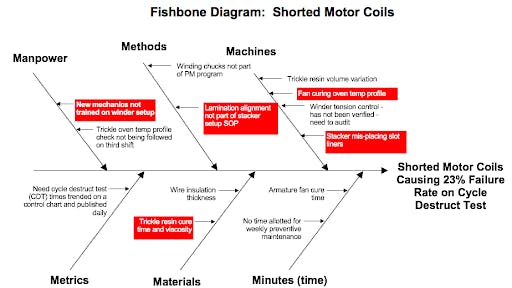Five Common Manufacturing Failure Analysis Techniques
In a manufacturing environment, “failure” refers to a loss in production continuity, which, in turn, can be caused by failed production equipment or manufactured parts deviating from defined quality parameters. These failures directly affect the profitability of a production facility and expose a company to significant risk. They need to be analyzed and handled efficiently to rectify the causes or to limit the frequency of potential failures in the future. This article will describe some of the more commonly used manufacturing failure analysis techniques.
What is Failure Analysis?
Most manufacturing failure analysis techniques follow the basic methodology of root cause analysis (RCA). As the name suggests, root cause analysis helps find the underlying cause for a failure, either on an individual part level or a series production level. The idea is to keep investigating the chain of events that led to the ultimate failure until you find the fundamental reason. Root cause analysis solves an existing problem while an FMEA predicts potential root causes. For manufacturing, production-based RCA discovers the causes of parts not adhering to quality standards or even the causes of unreliable production lines.
1. Failure Modes and Effects Analysis (FMEA)
This manufacturing failure analysis technique predicts the likelihood of potential failures, while also quantifying their consequences. A failure mode is a physical process that leads to a failure, while “effects analysis” refers to the potentially destructive consequences caused by these failures. FMEA examines the materials, the manufacturing methods, the types of equipment used, and any environmental factors that could contribute to or cause a failure. It is sometimes referred to as a “what if” analysis. Ideally, before implementing a new process or manufacturing a new product, manufacturers conduct an FMEA. When completed during the design/prototype phase, it helps identify any risks before production and reduces the risks inherent in any new product or process. FMEA, however, tends to be time-consuming.
2. Fishbone Diagram
A fishbone diagram is a visual tool that graphically represents the potential root causes. The illustration consists of 2 key elements: the head represents the effect or failure, and each “bone” represents a category of potential causes. They are as listed:
- Machines
- Methods
- Materials
- Manpower
- Metrics
- Minutes (time).
Each of these categories will make up one bone of the diagram.
Once filled out, the diagram determines the root cause by identifying repeated causes or the frequency where they appear. Alternatively, the team reaches a common consensus on the root cause based on new insights gained through the process. One disadvantage, however, is the potential of trying to solve every problem identified instead of those directly contributing to the ultimate failure.

Source: Fishbone Diagram
3. Logic Fault Tree
A logic fault tree is a manufacturing failure analysis technique that uses a top-down tree structure where the defined fault is at the top of the structure and the base roots represent the underlying cause of the fault. A logic fault tree helps identify the physical, human and organizational roots of a failure. Logical operators define the relationships between the different nodes on the tree, while a well-defined fault identifies all the potential causes. Poorly defined faults slow the process of analyzing inconsequential causes. A probability defines each cause on the tree. The overall fault tree failure likelihood is analyzed using these probabilities and the predefined relationships between the different causes.
4. The 5 Whys
This manufacturing failure analysis technique is a simple way of quickly getting to the root cause. The process starts with a failure, and you ask the question ‘why’ each time there is an identified cause. This activity repeats until there is an identified root cause or an uncontrollable process. The number five is not a hard limit but rather a guideline. You can determine a root cause after two to 10 whys, depending on the complexity of the problem. Reframing the failure from a few different perspectives often helps map out the causes. The 5 whys method is not as rigorous as the others but can sometimes be as effective and cut out unnecessary administration.
5. Data Analytics
With the ever-expanding “fourth industrial revolution,” modern manufacturing facilities have increasing access to rich data sets with data collected from a range of inexpensive IoT sensors used to monitor process-defining parameters such as machine temperature or vibration. Determining the root cause of a production line is analyzed through historical data. Statistical techniques are also used on these datasets to predict potential failures on equipment before they cause a costly breakdown. This method of manufacturing failure analysis is becoming more prevalent with cheaper sensors and more capable software tools. Affordable and convenient failure analysis tools with proven statistical process modeling techniques allow companies to focus on prevention through preventative maintenance.
Which Manufacturing Failure Analysis Technique is Best?
Deciding on which manufacturing failure analysis technique to use often depends on the complexity of the failure, its criticality, and existing quality control procedures. The methods listed in this article are only a fraction of the potential analysis tools available. Collecting pure data on the actual fault helps the trend toward data analytics grow (e.g. real-time collection of data instead of being collected from multiple sources after). These methods allow smaller agile teams to quickly iterate through potential causes and arrive at the root cause faster than traditional manual techniques. To learn more about how manufacturing failure analysis can get to the root of existing failures or even prevent future failures, contact a Xometry expert.

